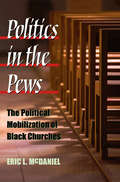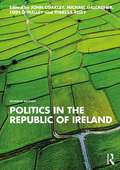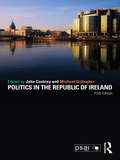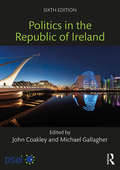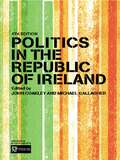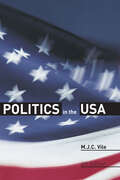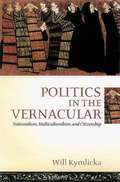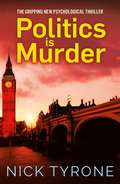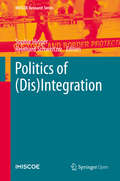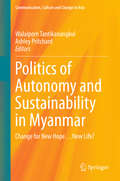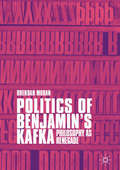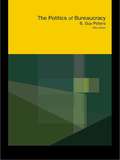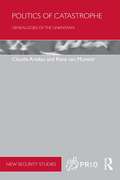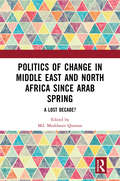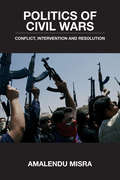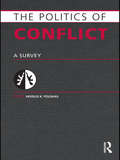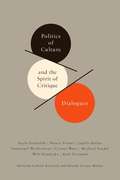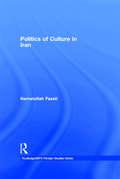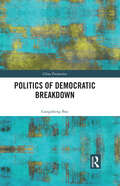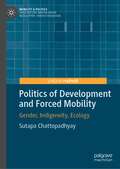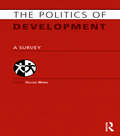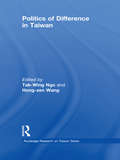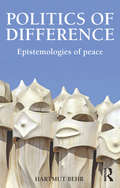- Table View
- List View
Politics in the Pews: The Political Mobilization of Black Churches
by Mcdaniel Eric L."Politics in the Pewsprobes the internal dynamics of political decision making within the Black church. " ---William E. Nelson, Jr. , Research Professor, Department of African American and African Studies, Ohio State University As Eric McDaniel demonstrates in his study of Black congregations in the U. S. , a church's activism results from complex negotiations between the pastor and the congregation. The church's traditions, its institutional organization, and its cultural traditions influence the choice to make politics part of the church's mission. The needs of the local community and opportunities to vote, lobby, campaign, or protest are also significant factors. By probing the dynamics of churches as social groups, McDaniel opens new perspectives on civil rights history and the evangelical politics of the twenty-first century. Politics in the Pewscontributes to a clearer understanding of the forces that motivate any organization, religious or otherwise, to engage in politics. Eric L. McDaniel is Assistant Professor in the Department of Government at the University of Texas at Austin.
Politics in the Republic of Ireland
by Michael Gallagher John Coakley Theresa Reidy Eoin O’MalleyBuilding on the success of previous editions, Politics in the Republic of Ireland continues to provide an authoritative introduction to all aspects of government and politics in this seventh edition. Written by some of the foremost experts on Irish politics, it explains, analyses and interprets the background to Irish government and contemporary political processes. It devotes chapters to every aspect of contemporary Irish government and politics, including the political parties and elections, the constitution, deliberative democracy, referendums, the Taoiseach and the governmental system, women and politics, the position of the Dáil, and Ireland’s place within the European Union. Bringing readers up to date with the very latest developments, especially with the upheaval in the Irish party system and the implications of recent liberalising referendums, the seventh edition combines substance with a highly readable style, providing an accessible book that meets the needs of all those who are interested in knowing how politics and government operate in Ireland.
Politics in the Republic of Ireland
by Michael Gallagher John CoakleyPolitics in the Republic of Ireland is now available in a fully revised fifth edition. Building on the success of the previous four editions, it continues to provide an authoritative introduction to all aspects of politics in the Republic of Ireland. Written by some of the foremost experts on Irish politics, it explains, analyzes and interprets the background to Irish government and contemporary political processes. Bringing students up to date with the very latest developments, Coakley and Gallagher combine real substance with a highly readable style, providing an accessible textbook that meets the needs of all those who are interested in knowing how politics and government operate in Ireland.
Politics in the Republic of Ireland
by Michael Gallagher John CoakleyPolitics in the Republic of Ireland is now available in a fully revised sixth edition. Building on the success of the previous five editions, it continues to provide an authoritative introduction to all aspects of the government and politics in the Republic of Ireland. Written by some of the foremost experts on Irish politics, it explains, analyses and interprets the background to Irish government and contemporary political processes. It devotes chapters to every aspect of contemporary Irish government and politics, including the political parties and elections, the constitution, the Taoiseach and the governmental system, women and politics, the role of parliament, and Ireland’s place within the European Union. Bringing students up to date with the very latest developments, especially with the upheaval in the Irish party system, Coakley and Gallagher combine substance with a highly readable style, providing an accessible textbook that meets the needs of all those who are interested in knowing how politics and government operate in Ireland.
Politics in the Republic of Ireland
by Michael Gallagher John CoakleyPolitics in the Republic of Ireland is now available in a fully revised fourth edition. Building on the success of the previous three editions, this text continues to provide an authoritative introduction to all aspects of politics in the Republic of Ireland. Written by some of the foremost experts on Irish politics, it explains, analyzes and interprets the background to Irish government and contemporary political processes. Crucially, it brings the student up-to-date with the very latest developments.New patterns of government formation, challenges to the established political parties, ever-deepening, if sometimes ambivalent, involvement in the process of European integration, a growing role in the politics of Northern Ireland and sustained discussion of gender issues are among these developments – along with evidence, revealed by several tribunals of enquiry, that Irish politics is not as free of corruption as many had assumed.
Politics in the USA
by M.J.C. VileThis highly acclaimed introduction to the essential elements of the American political system is now available in a new edition, having been fully revised and updated to take into account the considerable developments in American politics over the last ten years. Written in an accessible manner, Politics in the USA establishes a framework from which to understand the intricacies of politics in the world's most powerful nation. This new edition provides students with: essential background and history of the American political system as well as an explanation of the key structures, processes and institutions a chapter on the significant developments in US foreign policy under Clinton and George W. Bush analysis of Bush's Presidency and the rise of neo-conservatism discussion of controversial issues such as gun control, abortion, gay rights, and stem cell research suggestions for further reading and websites in each chapter. This is the most accessible, comprehensive and up-to-date textbook on American politics and will be of interest to students of American politics and international relations and politics.
Politics in the Vernacular: Nationalism, Multiculturalism and Citizenship
by Will KymlickaThis volume brings together fifteen of Will Kymlicka's recent essays on nationalism, multiculturalism and citizenship. These essays expand on the well-known theory of minority rights first developed in his Multicultural Citizenship. In these new essays, Kymlicka applies his theory to several pressing controversies regarding ethnic relations today, responds to some of his critics, and situates the debate over minority rights within the larger context of issues of nationalism, democratic citizenship and globalization political processes.
Politics is Murder: a darkly comic political thriller full of unexpected twists and an unforgettable heroine
by Nick Tyrone'A hilarious political satire bursting with black humour with an unforgettable anti-heroine' 5* Review'A fast-paced, witty and entertaining political thriller' 5* ReviewCharlotte Heard is one of few women in the male-dominated world of a Westminster think tank. Quick-witted and resourceful she is a senior member of the team and the young women in the organisation look up to her. But she is determined to realize her ambition to become an MP.Her dream seems within reach when she finds herself in the midst of a shocking murder investigation. Someone is trying to frame her and Charlotte must find out why.Can she uncover the truth or will it derail everything she has worked for?A gripping political thriller set in the heart of Westminster for fans of Quintin Jardin's State Secrets and Tony Kent's Killer Intent.Readers love Politics is Murder:'A gripping story of evil in the influential but murky world of think tanks' Sir Oliver Letwin'A tongue-in-cheek, Tarantino-style tour through the Westminster world of think tanks and parliamentarians' Professor Tim Bale, Queen Mary University of London'The story takes some unexpected twists and turns, into less recognisable situations that will have you laughing, turning the pages and pulling you along... Enjoyable, fast moving and well-observed throughout' 5* review
Politics is Murder: a darkly comic political thriller full of unexpected twists and an unforgettable heroine
by Nick Tyrone'A hilarious political satire bursting with black humour with an unforgettable anti-heroine' 5* Review'A fast-paced, witty and entertaining political thriller' 5* ReviewCharlotte Heard is one of few women in the male-dominated world of a Westminster think tank. Quick-witted and resourceful she is a senior member of the team and the young women in the organisation look up to her. But she is determined to realize her ambition to become an MP.Her dream seems within reach when she finds herself in the midst of a shocking murder investigation. Someone is trying to frame her and Charlotte must find out why.Can she uncover the truth or will it derail everything she has worked for?A gripping political thriller set in the heart of Westminster for fans of Quintin Jardin's State Secrets and Tony Kent's Killer Intent.Readers love Politics is Murder:'A gripping story of evil in the influential but murky world of think tanks' Sir Oliver Letwin'A tongue-in-cheek, Tarantino-style tour through the Westminster world of think tanks and parliamentarians' Professor Tim Bale, Queen Mary University of London'The story takes some unexpected twists and turns, into less recognisable situations that will have you laughing, turning the pages and pulling you along... Enjoyable, fast moving and well-observed throughout' 5* review
Politics of Public Money
by David A. GoodPublic money is one of the primary currencies of influence for politicians and public servants. It affects the standards by which they undertake the nation's business and it impacts on the standard of living of the nation's citizens. The Politics of Public Money examines the extent to which the Canadian federal budgetary process is shifting from one based on a bilateral relationship between departmental spenders and central guardians to one based on a more complex, multilateral relationship involving a variety of players.In this innovative study, David A. Good examines this shift in terms of a broader societal change from an 'old village,' conditioned by old norms of behaviour, to a 'new town,' which brings with it new ideas about how public money should be managed and spent. Organized into four parts, the book opens with 'The Changing Politics of Public Money,' which sets out a revised and expanded framework for analysing the politics and management of public money. Part 2, 'The Public Money Players,' looks at the motivations, interdependence, and independence of the four budget players. The third part, 'The Public Money Processes," deals with the central functions of budgeting - determining fiscal aggregates, making budget allocations, and ensuring effective financial management. Finally, 'New Prospects for Public Money,' looks ahead to the future and considers ways to strengthen the interaction among the players, and in so doing, improve the politics and management of public money.An insightful and incisive study of the changing budgetary process, The Politics of Public Money examines the promises and pitfalls of budgetary reform and sheds new light on the role insiders play in influencing government spending.
Politics of (IMISCOE Research Series)
by Sophie Hinger Reinhard SchweitzerThis open access book explores how contemporary integration policies and practices are not just about migrants and minority groups becoming part of society but often also reflect deliberate attempts to undermine their inclusion or participation. This affects individual lives as well as social cohesion. The book highlights the variety of ways in which integration and disintegration are related to, and often depend on each other. By analysing how (dis)integration works within a wide range of legal and institutional settings, this book contributes to the literature on integration by considering (dis)integration as a highly stratified process. Through featuring a fertile combination of comparative policy analyses and ethnographic research based on original material from six European and two non-European countries, this book will be a great resource for students, academics and policy makers in migration and integration studies.
Politics of Autonomy and Sustainability in Myanmar
by Walaiporn Tantikanangkul Ashley PritchardThis book focuses on the tensions between and conflict resolution processes concerning minority ethnic groups in Myanmar's rural areas and the State. It covers topics such as relations and communication between the central government, the Kokang Chinese community and the Kachin State; the impact of cyclone Nargis on remote settlements in the Ayeyarwady Delta; the impact of depletion of mangrove forests and Yangon's fuel needs on a Karen minority group; and the collapse of a community forestry project in a Pa-O village in Shan State. Written by young scholars from Myanmar, some of whom belong to minority groups, the book provides firsthand reporting and scholarship that, for the past sixty years, have not been available. Offering in-depth, unique insights into minority change issues in the interior and at the periphery of Myanmar, as seen from local perspectives, it offers a valuable resource for academics, students and researchers in the fields of sustainable development, social and political studies, and development communication in Asia.
Politics of Benjamin’s Kafka: Philosophy As Renegade
by Brendan MoranThis book provides a critical assessment of Benjamin’s writings on Franz Kafka and of Benjamin’s related writings. Eliciting from Benjamin’s writings a conception of philosophy that is political in its dissociation from – its becoming renegade in relation to, its philosophic shame about – established laws, norms, and forms, the book compares Benjamin’s writings with relevant works by Agamben, Heidegger, Levinas, and others. In relating Benjamin’s writings on Kafka to Benjamin’s writings on politics, the study delineates a philosophic impetus in literature and argues that this impetus has potential political consequences. Finally, the book is critical of Benjamin’s messianism insofar as it is oriented by the anticipated elimination of exceptions and distractions. Exceptions and distractions are, the book argues, precisely what literature, like other arts, brings to the fore. Hence the philosophic, and the political, importance of literature.
Politics of Bureaucracy
by B. Guy Peters Guy PetersFirst published in 2002. Routledge is an imprint of Taylor & Francis, an informa company.
Politics of Catastrophe: Genealogies of the Unknown (PRIO New Security Studies)
by Claudia Aradau Rens Van MunsterThis book argues that catastrophe is a particular way of governing future events – such as terrorism, climate change or pandemics – which we cannot predict but which may strike suddenly, without warning, and cause irreversible damage. At a time where catastrophe increasingly functions as a signifier of our future, imaginaries of pending doom have fostered new modes of anticipatory knowledge and redeployed existing ones. Although it shares many similarities with crises, disasters, risks and other disruptive incidents, this book claims that catastrophes also bring out the very limits of knowledge and management. The politics of catastrophe is turned towards an unknown future, which must be imagined and inhabited in order to be made palpable, knowable and actionable. Politics of Catastrophe critically assesses the effects of these new practices of knowing and governing catastrophes to come and challenges the reader to think about the possibility of an alternative politics of catastrophe. This book will be of interest to students of critical security studies, risk theory, political theory and International Relations in general.
Politics of Change in Middle East and North Africa since Arab Spring: A Lost Decade?
by Muddassir QuamarA decade since the eruption of Arab Spring protests in the Middle East and North Africa, the region continues to confront the primary causes of the popular disenchantment including economic deprivation, bad governance, corruption and limited avenues for political expression. Democratisation, the buzzword in 2011 has given way to debates around conflict management and resolution. Simultaneously, there are mounting economic challenges throughout the region that have been aggravated by the COVID-19 pandemic. But there are some silver linings such as a focus on reforms, greater scrutiny against corruption, demand for better governance, and awareness regarding women empowerment and rights of minorities. The volume, Politics of Change in the Middle East and North Africa since Arab Spring: A Lost Decade?, commemorates the ten years of the eruption of Arab Spring protests. It captures some of the prevailing political, economic, strategic and social issues in MENA through thematic or country-specific essays that explore the ongoing transformations and underline how despite the hopelessness, the MENA societies have made progress on various fronts. Print edition not for sale in South Asia (India, Sri Lanka, Nepal, Bangladesh, Pakistan and Bhutan).
Politics of Civil Wars: Conflict, Intervention & Resolution
by Amalendu MisraCivil war is one of the critical issues of our time. Although intrastate in nature, it has a disproportionate and overwhelming effect on the overall peace and stability of contemporary international society. Organized around the themes of contested nationalism, violence, external intervention, post-conflict reconstruction, reconciliation and governance, Amalendu Misra investigates why civil wars have become so widespread and how can they be contained? Particularly noteworthy is its focus on the "cycle" of conflict, ranging as it does on the causes, conduct, and end of civil wars as well as on subsequent efforts to return post-conflict society to "normal" politics. Theoretically robust and empirically solid, this book clearly charts the course of contemporary civil wars using case studies from a variety of zones of conflict including Africa, Asia and Latin America to produce the most comprehensive guide to understanding civil wars in an interconnected and interdependent world.
Politics of Conflict: A Survey
by Vassilis K. FouskasFour sections present a thorough overview of current issues in the politics of conflict in historical perspective. Essay chapters written by a variety of academic and other experts on topics including conflicts in Latin America, Africa, the Caucasus and Central Asia, South Asia and South-East Asia, the Arab-Israeli Conflict and Yugoslavia provide background analysis and information on some of the key aspects of conflicts in the world. It also includes an A – Z glossary of conflicts in the world, Maps of countries and regions and a select bibliography.
Politics of Culture and the Spirit of Critique: Dialogues (New Directions in Critical Theory #27)
by Alfredo Gomez-Muller Gabriel RockhillThis book of tightly woven dialogues engages prominent thinkers in a discussion about the role of culture-broadly construed-in contemporary society and politics. Faced with the conceptual inflation of the notion of 'culture,' which now imposes itself as an indispensable issue in contemporary moral and political debates, these dynamic exchanges seek to rethink culture and critique beyond the schematic models that have often predominated, such as the opposition between "mainstream multiculturalism" and the "clash of civilizations." Prefaced by an introduction relating current cultural debates to the critical theory tradition, this book examines the politics of culture and the spirit of critique from three different vantage points. To begin, Gabriel Rockhill and Alfredo Gomez-Muller provide a stage-setting dialogue, followed by discussions with two major representatives of contemporary critical theory: Seyla Benhabib and Nancy Fraser. Working at the horizons of this tradition, Judith Butler, Immanuel Wallerstein, and Cornel West then provide important critical perspectives on cultural politics. The book's concluding section engages with Michael Sandel and Will Kymlicka, who work out of the Rawlsian tradition yet are uniquely concerned with the issue of culture, broadly understood. The epilogue, an interview with Axel Honneth, returns to the core issue of critical theory in cultural politics. Ranging from recent developments and progressive interventions in critical theory to dialogues that incorporate its insights into larger discussions of social and political philosophy, this book sharpens old critical tools while developing new strategies for rethinking the role of 'culture' in contemporary society.
Politics of Culture in Iran (Routledge/BIPS Persian Studies Series)
by Nematollah FazeliThis first full-length study of the history of Iranian anthropology charts the formation and development of anthropology in Iran in the twentieth century. The text examines how and why anthropology and culture became part of wider socio-political discourses in Iran, and how they were appropriated, and rejected, by the pre- and post-revolutionary regimes. The author highlights the three main phases of Iranian anthropology, corresponding broadly to three periods in the social and political development of Iran: *the period of nationalism: lasting approximately from the constitutional revolution (1906-11) and the end of the Qajar dynasty until the end of Reza Shah’s reign (1941) *the period of Nativism: from the 1950s until the Islamic revolution (1979) *the post-revolutionary period. In addition, the book places Iranian anthropology in an international context by demonstrating how Western anthropological concepts, theories and methodologies affected epistemological and political discourses on Iranian anthropology.
Politics of Democratic Breakdown (China Perspectives)
by Gangsheng BaoDemocratic breakdown as a political and historic event can impact the fate of millions, if not hundreds of millions of people, by changing the political complexion of a country. This book attempts to systematically explain why democracies collapse.The author's main theoretical argument is based on the examination of two factors. One is political cleavages among voters. These can cause serious political conflicts and may lead to fierce political confrontation and major upheaval at the society level. The other revolves around the types of political and institutional arrangements under democratic regimes. Centrifugal democratic regimes are likely to weaken government capacity or state capacity, rendering governments incapable of effectively resolving political conflicts and, when these two factors come together, political conflicts are less likely to be controlled effectively. These situations can evolve into serious political crises and eventually lead to the collapse of democratic regimes. The empirical research of this book is based on a comparative historical analysis of Germany, Nigeria, Chile, and India. Examining democratic collapses from both theoretical and empirical perspectives, this book will be of interest to those engaged in the study of democracy, Political Science, Comparative Politics, and Political Theory.
Politics of Development and Forced Mobility: Gender, Indigeneity, Ecology (Mobility & Politics)
by Sutapa ChattopadhyayThis book broadly analyzes the displacement or forced relocation of Adivasis Indigenous peoples from the Narmada Valley in India due to the construction and execution of a large development project, the Sardar Sarovar project, which has substantially transformed Adivasi lives, roles, practices, and autonomy, and increased their dependence on capital, market, unsustainable farming practices and urban jobs. Globally, Indigenous communities live within a legacy of environmental dispossession due to economic development that dismantles their mental and physical well-being and a land-based way of life. Appropriation, dispossession, and accumulation is historical and contemporary. Stories of Adivasi people illustrate the horrors of systematic marginalization, in general, and Adivasi women’s reduced autonomy and economic sufficiency, in particular. Key to mention here is that decades of resistance, protests, counter-struggles, marches, direct action did not overturn bureaucratic regressions or structural and direct violence towards marginalized or resettled Adivasi people, but enabled networks of solidarity arguing their rights and access. The book does not attest to state or corporate power, but validates Adivasi agency and autonomy.
Politics of Development: A Survey
by Heloise WeberThe Politics of Development: A Survey provides an overview of the intrinsically political relations of development. It brings together essays written by experts in the politics of development and covers a range of significant and topical concerns: gender, race, indigenous development, social movements, religion, security, environmental concerns, colonialism and its legacies, migration, the political economy of development, trajectories in urbanization, and the agrarian question. It introduces and examines key concepts and approaches which have underpinned development, as well as the struggles it has engendered historically, and in contemporary contexts. This volume provides critical insights into the global politics of development and offers alternative analytical frameworks for understanding the relationships around development and inequalities. The Politics of Development: A Survey is organized in an accessible manner, catering to a wide audience (ranging from undergraduates at University level to practitioners and Non-Governmental Organizations [NGOs] engaged in advocacy as well as practical political aspects), and provides introductions to key issues and themes around contemporary challenges and opportunities in development. The title also includes an A-Z Glossary, covering key terms, organizations, concepts and actors in the politics of development.
Politics of Difference in Taiwan (Routledge Research on Taiwan Series)
by Tak-Wing Ngo Hong-Zen WangTaiwan has been hailed as a successful case of democratization. Compared with many other nations, the transition from authoritarian rule occurred in a rather orderly fashion. Group consciousness emerged as a reaction to the decades-long suppression of cultural diversity under martial law as different social groups competed fiercely to exert their political subjectivity. This volume is the first study to examine the politics of difference in Taiwan. It aims to go beyond ethnic identity as the sole concern for group boundary, to acknowledge the interests of other marginalized groups, and to look behind reified group boundaries in order to discover group differences as mediated social relations based on overlapping boundaries rather than exclusive opposition. In exploring the politics of difference among minority groups and the problems arising from their struggle over political recognition, the book challenges the assumptions that groups are ontologically given, that groups are internally homogenous, and that the particularistic identities have no overlap. The chapters offer a broad coverage of major social groups including ethnic minorities, recent migrants, gay and lesbian groups, and marginalized workers. They offer perspective analyses of the ongoing struggles by minority groups to overcome subordination. .
Politics of Difference: Epistemologies of Peace
by Hartmut BehrThis book develops a notion of differences and 'otherness' beyond hegemonic and hierarchical thinking as represented by the legacies of Western philosophical and political thought. In doing so, it relates to the phenomenological discourse of the twentieth century, especially to Georg Simmel, Alfred Schütz, Emmanual Lévinas, and Jacques Derrida, and drafts our understanding of difference as a genuine human experience of a social and political world that is in motion and transformative, rather than static and predictable. On this basis of temporalized ontology and its normative consequences, differences are drafted as a positive social and political force and as powerful capacities of transformation and change. In practical terms, this understanding is most important for our theorizing and acting upon peace, peace-building, and conflict solution. Differences now appear not as obstacle to peace and reconciliation, but as lively and constructive articulations of 'otherness' and as a positive power of transformation, emancipation, and change. This book will be of interest to students of international relations, philosophy and political theory.
